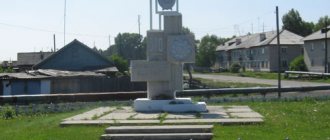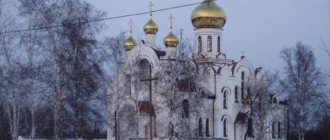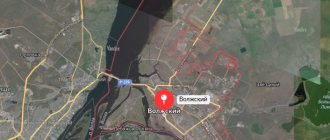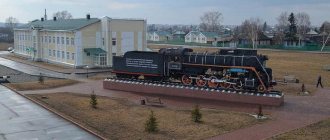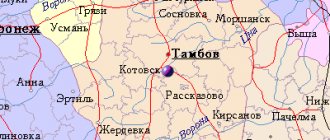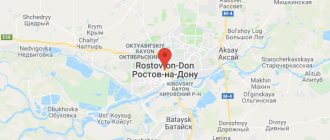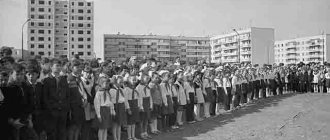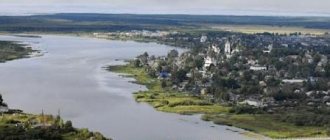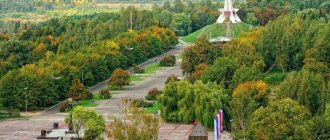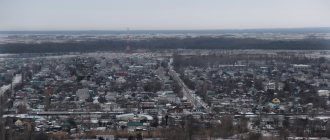General information and history of the city of Cheboksary
When people hear the name of this city, a phrase from a wonderful children's cartoon pops up in their minds: “Cheboksary, Cheburek, Suitcase... but there is no Cheburashka.” There really are no Cheburashki in the city, but there is a wonderful bay, well-groomed streets and avenues, green parks and national color.
Cheboksary is a city of love!
The history of the city goes back more than 5 centuries. The first chronicle mentions date back to 1469. The wars of John IV on the way to the Kazan Khanate stopped in a small settlement on the right bank of the Volga. This date was taken as the starting point for the history of the city. However, local pundits are diligently trying to add a couple of centuries to the city.
In 1555, the city officially became part of the Moscow Principality. Numerous works of art are dedicated to this event, including the famous bas-relief in the lobby of the city administration building, where a group of people in national Chuvash costumes shake hands with Ivan the Terrible, and a Chuvash maiden, down on one knee, brings the king a ladle of local beer. Very realistic bas-relief.
By the 17th century, not a trace remained of the fortress that was founded here. However, the settlement did not disappear without a trace in the Volga forests. On the contrary, the city began to grow and develop, and production appeared. The settlement was especially famous for its bell foundries. And, if not for two large shopping centers such as Nizhny Novgorod and Kazan, then perhaps the city would have had a different, more glorious fate. However, Catherine II, traveling along the Volga, noted that Cheboksary “is better than Nizhny Novgorod in everything.”
In the 18th and 19th centuries the city developed as a trading center. Red Square, which is now located at the bottom of the Gulf, gathered a crowd of thousands of traders coming from all the surrounding villages, not only Chuvash and Russian, but also Mari, Tatar, and Mordovian. What was Cheboksary trading famous for in those days? First of all, these are malt, wine, leather, potatoes, candles. Well, the bells have already been mentioned above.
Cheboksary Bay
In the 20s, Cheboksary became the capital of the newly created Chuvash Autonomous Republic. In fact, it was a completely random choice. The city was neither the largest nor the most developed. Apparently the advantageous geographical location played a role. — 56020′ north latitude, 47010′ east longitude. Very good location. Distance to the capitals of the nearest neighboring regions: Kazan - 181 km; Nizhny Novgorod - 247 km; Ulyanovsk - 244 km; Yoshkar-Ola - 93 km. And it’s not very far from Moscow - 661 km.
The city of Cheboksary itself occupies a fairly large area of 25 thousand hectares. Considering the population of 455 thousand, per 1 sq. km there are approximately 45 people.
In general, from a historical and geographical point of view, the city has become a wonderful place to live.
Cheboksary Airport
There is an international airport in Cheboksary, which has the status of a federal facility. The airfield is considered the base airport of Chuvashia Airlines. Opening hours: from 4:00 to 19:00. The year of opening is 1963. On the territory of the airport there is an increased comfort zone, a hotel complex, a luggage storage room, and free car parking.
The most popular destinations of regular and charter flights: Moscow, Simferopol, Sochi, Ufa, Anapa, Antalya. The airport serves domestic and international flights of major airlines: Pobeda, Nordwind, Smartavia, Orenburg, Pegas Fly. The average passenger traffic per year is more than 250 thousand people.
Climate and ecology Cheboksary
Well, what can you say especially about the climate of the middle zone? In winter it is cold and snowy. The winds in the city are not very strong, with the exception of the northwestern part of the city. According to rumors and urban legends, there is some kind of tectonic fault there. No one can say how this affects the strength of the wind, but the winds there are really strong. Despite this, the area is considered prestigious, so wealthy and influential people live there.
The air in the city is characterized by humidity, due to the fact that Cheboksary is located on the very bank of the Volga. This closeness is especially felt in the spring, when the river is freed from ice. The average temperature in winter is 15-18 degrees. It can, of course, get colder. City chronicles remember 1977, when the temperature dropped to -45. Pipes and radiators burst, birds and apple trees froze.
Winter Cheboksary
But in the summer the climate in the city changes to mild and warm. A large number of green spaces, such as parks, gardens, squares and forests, create enough shade in the capital of Sunny Chuvashia and enrich the city with oxygen. And again, the Volga saves the townspeople from the hypothetically possible heat. The average temperature in summer is 21-25 degrees.
About 15 years ago, Cheboksary was considered an industrial city. The huge Cotton Mill, the Aggregate and Tractor Plants, Elara, Energo-Zapchast and several other large industrial complexes worked at full capacity, enriching the atmosphere with useful and necessary elements for which the table named after them is so famous. Mendeleev. Now there are only a few factories left that are not operating at full capacity, so the air in the city has become clean and transparent. And it even smells like linden trees in spring and pine needles in summer. True, sometimes at night the city guards of the Aggregate Plant still delight the city, reminding us of the former greatness of the industrial city with the smell of hydrogen sulfide. And even then, it only goes to the adjacent block and not every week.
Cheboksary CHPP
In the neighboring city of Novocheboksarsk there is still Khimprom, a large and large plant. However, the wind rose directs all possible flows of life of this plant towards the Mari Republic. So, they say everything is safe and clean. All the townspeople believe this.
What else the region is famous for is the Cheboksary hydroelectric power station. There is a lot of gossip about how it has not been operating at full capacity since its founding. They will raise the water level to the proper level. There will be a lot of fish, clean water and flooded forests. The view from many city windows will clearly improve, as the forest horizon will move a couple of kilometers away, and the river waters will be covered with snow-white sails of elegant yachts. It will be very beautiful.
Yes, however, even now the city is distinguished by its cleanliness and improvement. In 2001, the city was recognized as “The cleanest and most comfortable city in Russia.” Mayors have been diligently maintaining this state for the last 10 years. But the city was no longer given bonuses.
Automobile highways
The following federal roads pass through Cheboksary:
- M7 "Volga" is a federal highway, the total length of which is 1351 km. It is part of European routes E22 and E107. The route originates in Moscow and goes through Nizhny Novgorod, Kazan, Vladimir. The final destination of the road is Ufa. Road surface: Asphalt.
- P176 “Vyatka” is a federal highway that runs through the territory of Russia. The route leads to the following cities: Yoshkar-Ola, Kirov, Syktyvkar. The total length of the highway is 872 km. Road surface: asphalt concrete.
- E22 is a European route that originates in the British city of Ishim. The road passes through the cities of Russia, the Netherlands, Great Britain, Latvia, Sweden, and Germany. The final point of the route is the Russian city of Ishim. The total length of the European route is 5,320 km.
Population of Cheboksary
In Chuvashia there is such an organization as Chuvashstat. She is the one who does all sorts of calculations. A very useful organization. So, according to this structure, over the past 20 years the population has grown by more than 150 thousand people. If in the middle of the last century the main increase in population was due to workers of factories and combines transported to Cheboksary during the war and post-war periods, now these are villagers of the Chuvash Republic who came to the city to study, trade, start families and try to get rich. For these reasons, the national composition of Cheboksary has changed greatly.
Celebrating Maslenitsa in the city
Just a couple of decades ago, the city was predominantly Russian. Now the proportions have changed. And quite strongly. When compared with other national republics, in Cheboksary, at first glance, nationalism is not as painful and blatant as in neighboring Tatarstan or Bashkiria, but it also does not exist in such a mild form as in Mari-El. Let's just say that national confrontation is present in kitchen conversations. It is considered indecent to speak openly about the dominant nature of a particular cultural heritage. So the Russian part of the city is silent, but the numerous Chuvash part is developing. True, in the mid-90s slogans about national self-determination and the eviction of alien elements from the republic were popular. This quickly stopped. Everyone went about their business and learned to exist peacefully with each other.
Of course, on the streets of the city you will quite often come across people of different ages speaking the Chuvash language, the signs in the city are duplicated in Chuvash, the names of the streets too, but you will not have any difficulties in the store, at the post office, in the hospital and in municipal institutions. You will quickly go through national identification and hear Russian speech in response to any of your requests. The main thing is to understand the slight accent. But it's not difficult.
The national language is very unique; it belongs to the Turkic group of languages and is particularly archaic and lacks a feminine gender. When you first hear it, it may seem that people in front of you are swearing, and using obscenities. However, it is not. Native speakers themselves believe that they have very musical, lyrical and beautiful linguistic phonetics.
The existence of Chuvash diasporas from different regions of the Republic in the city of Cheboksary itself will be indicative. There are about 25 of them. Meetings are held once a month and issues of development and maintenance of ancient Chuvash culture are discussed. As part of the meetings, sports events, dance and song competitions are organized. People like it.
If we talk about the ethnic composition of Cheboksary, now 2/3 of the population are Chuvash, 1/5 Russian, the remaining share is shared by Tatars, Mari, Ukrainians and other nationalities. It is especially worth noting that there are not many people from the North Caucasus in the city.
In general, to understand the atmosphere of the city, you need to know a little about the cultural history of the Chuvash people and their attitude towards their own role in the world community. Let's start with the fact that the Chuvash alphabet appeared in 1873. Writing was finally formed by 1949 with the appearance of the last 37th letter “Y”. Many prominent Chuvash scientists, however, talk about the presence of writing already at the dawn of civilization. They suggest runic writing or writing in the form of pentagrams. Or even based on cuneiform. The city even has a stone with an ancient runic alphabet.
Sculpture “Symbols of Wisdom”
You most likely will not find written sources, but they will definitely show you Chuvash embroidery so that you can see with your own eyes that there was writing. About 10 years ago there was a series of articles in the local press devoted to the history of the formation of Chuvash culture. So there, pundits with a philological bent proved not only the Sumerian origin of the Chuvash, but also talked about the Chuvash roots of Aztec culture. We are very thirsty for knowledge. And they love to share with others everything that has been learned. The townspeople are especially proud of their national-historical community with the state that existed a little further down the Volga - Volga Bulgaria.
In general, the population of Cheboksary is quite young. 50 percent are among people between 20 and 45 years old. There are many children - as the demographic program of the President of the Russian Federation is being actively implemented in the city. It should be noted that the city has a fairly friendly atmosphere. On the streets you will not meet drunks, people without a fixed place of residence and hooligans. It is not known where they live, but it seems that they simply do not exist. The city is emotionally comfortable and cheerful, thanks to numerous mass celebrations.
Folklore group Sudarushka at mass celebrations in Cheboksary
Coat of arms
The coat of arms of Cheboksary is presented in the form of a French shield. On an azure background there are five silver ducks flying in the shape of an envelope. The scarlet field of the chapter is separated from the base by a zigzag line and contains three silver silhouettes of oak trees, stylized as a Chuvash ornament. The inner part of the two outer trees is red, the middle one is azure. The latter contains the silver number "1469". It indicates the date of the first mention of the city.
The shield is topped with three four-pointed octagonal purple stars edged in gold. Framed with a symmetrical gold-colored motif, closed at the bottom with a motto cartouche with a two-line inscription on a purple background “Shupashkar” - “Cheboksary”.
It is allowed to use the emblem without a frame. This option is called the Small Coat of Arms.
The artistic composition goes back to the historical version. It was approved by the decision of the Cheboksary City Assembly of Deputies of the Chuvash Republic dated August 4, 1998 No. 409 (as amended on December 24, 2009, March 6, 2012).
Districts and real estate Cheboksary
Officially, the city is divided into four districts, one of which is located on the left bank of the Volga River and consists of a number of small villages, camp sites, cordons and sanatoriums. Getting there is not very convenient - either by public and private transport via hydroelectric power stations at any time of the year, or by trams and ferry in the summer. You won't be able to swim - it's too far. There is no bridge - it is expensive to build. The remaining areas are separated by bridges. The breakdown in numbers is approximately as follows:
Kalininsky district - 150 thousand, Leninsky -123 thousand, Moskovsky -184 thousand people. The Volga region has about 12 thousand.
Map of Cheboksary districts
As you can see on the map, each of the four districts is divided into several more territories, which, however, bear quite official names. However, this is not all. Each of these districts is still divided into small territories, which received their names in the fascinating and turbulent 90s, when the so-called “boy” groups existed in the city, strictly guarding their halo of habitat. Many of them ceased to exist long ago, but the names remained in the minds of the townspeople. The “boys” have matured, put on suits, ties, some even cufflinks, but they still remember where their homeland is and whose blood they will be from.
The Moscow region is considered the most respectable. At least, the cost of housing here is the most expensive in the city, except for new houses in the center and a number of elite houses in the KhBK area. The average cost of a residential square meter in the Moscow region varies from 35 to 55 thousand rubles. It all depends on the type of building and location. The most expensive squares are in the area of Historical Hill or, as people say, Brick (there is an old brick factory on this territory), as well as in the North-Western microdistrict in the territories called Volzhsky-1, Volzhsky-3 and st. Talvira. The first president of Chuvashia lives here with his former officials, as well as the current nomenklatura fraternity and large businessmen.
New buildings in the Moskovsky district
There is a small village with large cottages called New Village. The cost of a land plot of 15 acres can reach up to 35 million rubles. The area of the former hippodrome, now the intersection of Moskovsky Prospekt and st., is also considered prestigious. Afanasyeva. There is practically no industry in the Moscow region, with the exception of the instrument industry, which produces units for avionics. The plant not only remained afloat, but also successfully replenishes the city’s treasury.
As for other parts of the region, they are significantly inferior in prestige to the North-West. True, it is worth noting that the South-Western region is distinguished by fairly decent houses in architecture and layout. However, the distance from the center and the Volga makes housing relatively inexpensive. About 30-35 thousand per square meter. Young families live here who have taken out a mortgage and are successfully paying for it. And also businessmen who managed to earn money for a two- or three-room apartment in two or three years. The place is quite comfortable.
As for the Chapaevsky village, it is a very interesting place. Built around the plant. Chapaev, he preserved the amazing atmosphere of provincial architecture. Many of the houses were built by German prisoners of war, which makes them incredibly cute. Everyone here knows each other. There are many elderly people who take special care of their flower beds and front gardens. Old engineers and designers who settled in the city after the construction of the plant began live here. They love and value their area. However, this area is popularly called the Village. The most desperate bandits and hooligans were from here. The city at one time was in awe of the “villages”.
Chapaevsky village
Leninsky district is a rather motley sight. The Center microdistrict is Karl Marx Street with administrative buildings and Republic Square, as well as the pearl of the city - the Bay - beautiful, clean and green.
Leninsky district
Everything else is essentially a ghetto. Bogdanka is an old two-story barracks, with amenities on the street and wood sheds, which are used both as warehouses and for their intended purpose. The only area in the city where you don’t want to not only live, but also just stop by on business. And there can be no business there. The road to the main city cemeteries runs through Bogdanka.
Dilapidated houses are a common sight on Bogdanka
True, the city has a development plan for this area. New houses began to appear, infrastructure was developing. People are waiting for changes and rejoicing at the emerging prospects.
Geographical center of the city
As for the Kalininsky district, it also consists of sectors with different quality of life.
The KhBK microdistrict is considered one of the most prestigious. This is due to both the location and those who settled here. Directors of large factories - active and not so much, ministers, the new head of the Republic, they all live next door. We can say that this is the cleanest and most well-groomed area of the city. Evenly trimmed linden trees, beautiful flower beds, repaired roads, constant lighting - all this pleases the inhabitants of the area. It should be noted that some of the houses here resemble the Chapaevsky village in their architecture, only they look like the houses of a German suburb - picturesque and alluring. Very good area. And since, thanks to the activities of the former president, the Cotton Mill ceased to exist, next to the area there is one of the largest shopping centers in the city, Mega Mall, located in industrial buildings.
But the most important attraction of the area is Victory Park. Blue spruce trees and an unforgettable view from the highest point of the city allow the inhabitants of this closed little world to enjoy peace and well-being.
View from Victory Park
Perhaps the most expensive real estate is here. Some apartments cost about 12-15 million rubles. True, their area is corresponding from 150 to 350 square meters. There are also small apartments. They are much cheaper. But it is extremely difficult to buy housing here.
Not far from this oasis of well-being are the districts “Chulochki” and “Agregatki”, in other words, the districts formed thanks to the Hosiery and Knitting Factory and the Aggregate Plant. These are working-class areas. Living here is not prestigious, but it is inexpensive. The bulk of visitors from villages settle here. It was so 40 years ago, and it is so now. The houses for the most part are brick buildings of 4-5 floors from the Khrushchev period of our history. There are many hostels built for working youth, who, having matured significantly, stayed to live here. A lot of everyday alcoholism and family dramas. However, children are having fun in the courtyards. The neighborhoods are noisy and fun. It is here that all the local district punks fear the watchful old women who stand guard over public and personal morality.
As for the New South district, it is the largest and most populous in the entire city.
Novo-Yuzhny
Built for the workers of the Tractor Plant, the area began to grow rapidly. Initially, young and not very specialists who came from all over the USSR lived here. They brought the wind of freedom, glimpses of a new mind, the smell of unprecedented dishes and forbidden literature. Engineers, chemists, metallurgists and techies, so attractive in the seventies, have firmly established themselves in this young part of the city. As time went. The plant needed a lot of new labor, and the area acquired new residents. The same young, as strong and healthy workers as the first wave of migrants. But they spoke mostly Chuvash and did not know who Feuerbach was. But they knew that the plant would certainly provide them with housing and good wages.
And the Tractor Plant did not deceive them. New houses were built, wide avenues ran through, and infrastructure was developed. Today's New South district is an area of fast monolithic houses, not very expensive shops and an incredible number of residents. Inexpensive, fun, noisy. As a rule, residents living here, when going to the Center or the North-Western region, notify their family, saying that they are “going to the city.”
City infrastructure
Talking about urban utilities is always difficult. And the complexity here does not lie in the diversity and versatility of the system. It all depends on what area you live in. The prosperous North-Western and Central regions and their inhabitants will say that the city is good for everyone: clean, comfortable, well-groomed. There are many kindergartens and schools, hospitals are working properly, the post office and telegraph office are not occupied by anyone, garbage is removed ahead of schedule, entrances are washed and repaired in a timely manner, trash cans are everywhere, bus stop pavilions are made of glass, there are flowerpots and beautiful flower beds on the streets that are constantly are being renewed, and on Mars the time for apple and cherry blossoms is about to begin. In a word, the city is a dream and the Pearl of the Volga region. And the price of utility services provided to prosperous residents of prosperous areas, of course, is not the cheapest, but they are worth it. They really are worth it.
Flower fish
If you live in a different area, then the problems undoubtedly increase. Snow removal in winter is not so good, entrances and courtyards are not cleaned as well, there are problems with kindergartens, the cost of utilities is high, trash cans are not every 30-40 meters, but every 60-70. Management companies periodically try to increase tariffs unilaterally.
Spring thaw on the roads
The roads are broken and garbage is not always removed on time. The average cost of utility bills is about 3 thousand rubles for a three-room apartment. This includes heating, water, electricity and other expenses. In some areas this price is slightly lower, and in some it exceeds 6-7 thousand. But, in fairness, let’s say this amount will be paid by the owners of fairly large apartments, with an area of 100 square meters. m.
Cheboksary Stalinka
However, all citizens will undoubtedly note the fact that the city has no problems with heating, hot or cold water supply, or power outages. Of course, there are emergency shutdowns, but the city service 074 works extremely quickly. Any malfunction is eliminated within a few hours. Maximum day. With the exception of planned repairs, about which residents of neighborhoods are notified several days in advance. The credit for such well-functioning work of the housing and communal services lies with the two previous mayors. One was engaged in the external improvement of the city, and the second changed everything that was hidden underground - that is, communications. There have never been emergency or rolling heat outages in Cheboksary during the winter. The city is almost completely illuminated.
True, there is a big drawback in the city economy - transport does not work around the clock. This greatly angers the townspeople who have gone on a spree. After one in the morning you have to call a taxi. Both buses and trolleybuses, as well as minibuses, stop running. Apparently the drivers decide that respectable citizens need to be at home at night. Very, very inconvenient installation.
Universitetskaya Street
There is also a serious problem in the city. The central part of Cheboksary was built without taking into account the increase in the welfare of citizens and the development of a bank lending system. The city planners of the twentieth century did not take into account that the city would have so many personal vehicles. They didn’t think about the future development of the domestic and world automobile structure. Therefore, there are few car parks and car parks in the center. And some of the highways and interchanges are too narrow. This creates traffic jams in the central part of the city, through which all major traffic flows pass. Authorities are trying to find solutions, laying out detour routes and even building new roads. But, alas! Cheboksary is located in a ravine area and all districts of the city are connected by bridges, which does not allow the expansion of the roadway. Therefore, traffic jams are still inevitable. Well, the road surface itself causes a lot of complaints from drivers. The asphalt is of very poor quality. Although a road repair program was launched in 2010. Some of the main highways were repaired.
New Roads
Cheboksary residents are in anxious anticipation of a miracle. They write letters to the administration, intrigue, tell sad stories of personal destinies, demanding the repair of exactly those roads that correspond to individual routes. In general, they live life to the fullest.
As for kindergartens and schools. The demographic crisis that arose in the 90s significantly reduced the population’s need for kindergartens. Everything seems to be fine with the schools. But the garden buildings and nurseries were sold by enterprises that could no longer afford to maintain half-empty buildings. Now that young families have embraced the baby boom idea, the demand for kindergartens has grown enormously. But it should be noted that through the efforts of the authorities, 6 kindergartens have been built in the city over the past few years.
Water resources of the area
Unfortunately, the environmental situation in Cheboksary has such a bad effect on drinking water that in some areas they even drink it not from the tap, but bought in a store or imported. This is facilitated by the very deplorable state of the city’s wastewater treatment plants. Since Soviet times, repairs have been carried out somewhere, if at all, in small quantities, and in some places nothing has been repaired since the 80s. Accordingly, treatment facilities cannot cope with the load of sewage from the capital of the Chuvash Republic and, roughly speaking, begin to “leak.” Also, the system for delivering wastewater to treatment plants is practically out of order. The irrigation system also does not work in the case of transporting water from precipitation from the surface of the earth. All these flows of dirty water find their way into reservoirs - the Cheboksary rivers and reservoir. And also, in the end, it all then flows into the Volga.
Enterprises and work in Cheboksary
Of course, in recent years in Cheboksary there has been a noticeable seasonal outflow of labor to large cities and regions of Russia. However, it cannot be said that there is a serious shortage of jobs in the capital of Chuvashia. A lot of work. You just need to work hard. And, as everywhere else, professionals are required. True, you can often hear from townspeople that the authorities have destroyed all production, and shopping and entertainment complexes have grown up in the place of workshops and enterprises. Glass, plastic, glossy tiles and chrome details transform the city into a modern and advanced metropolis. Beautiful. Trade in some centers is extremely brisk, while others are half empty. The point here is not only that there is an excessive number of them, but that the traders represent the same product. The buyer chooses the most convenient stores at their location.
There has been a Clothes Fair in the city for many years - almost everything that can be bought in the city’s malls is present here, but the price is strikingly different. We can safely say that trade is one of the leading sectors of the city’s economy, providing jobs to the city. The largest shopping and entertainment complexes in the city are “Mega Mall” located on the street. Kalinina, “Shupashkar” on Traktorostroiteley Avenue, House of Trade on the street. Karl Marx, "House of Fashion" located on the Bay, Shopping complex "Cascade" on Presidential Boulevard. Not long ago, chain hypermarkets appeared in Cheboksary: Metro, Karusel, Spar, Perekrestok, M-Video.
Mega mall in Cheboksary
Nevertheless, Cheboksary remained an industrial city, despite the fact that a number of enterprises ceased to exist. The cotton and paper mill no longer exists, but it was one of the largest in Russia and ranked 5th in the world in the production of cotton fabric. Other productions have also declined. However, the Tractor Plants Concern, which includes a number of enterprises throughout our vast homeland, is still operating successfully. People are constantly needed here, both in the workshops and in the administrative and economic sphere. Perhaps they can offer the highest income to their employees. The aggregate plant is also part of this concern. There is also the Elara enterprise. People who are lucky enough to pass the strict selection process of the HR department hold on to their jobs - a good social package and a fairly high level of income greatly contribute to this.
Tractor show
One gets the impression that the bulk of production capacity is in the field of machine tool and instrument making. So these are the most popular specialties.
11 large manufacturing enterprises and 43 outside the electrical industry make it possible to employ about 60% of the townspeople. The rest work in food production, trade, services, health care and education.
The construction sector is developing very actively. There are more than 85 construction organizations in Cheboksary. New neighborhoods are being built, road junctions, kindergartens and schools are being built. Moreover, it should be noted that the main urban construction is carried out from brick. Urban architecture will differ from other settlements in Russia with its joyful shapes and colors. Very neat looking.
Well, special attention should be paid to the agricultural sector. Whatever one may say, the republic is an agricultural one. Spring and autumn are important periods in the lives of city residents. The streets are empty, transport is free, prices in stores are falling - all the people turn their gaze towards ancestral lands and remember the behests of their ancestors. Potatoes, potatoes and more potatoes occupy the minds of Cheboksary residents. So at the Kolkhoz Market you will find everything that the Chuvash land is rich in. Food products produced in Chuvashia vary greatly in taste and quality. Dairy products, meat range and, undoubtedly, confectionery products are especially good. A very worthy enterprise, famous for its candies throughout Russia. The factory is constantly expanding and has its own branded chain of stores.
Popular message topics
- The creation and history of the sewing machine
The way we look today largely determines our appearance, first of all our clothes. Who would agree to walk around in homespun rags now?? Or a shirt hand-sewn with a needle! It's hard to even imagine. - Tyrannosaurus
Scientists are still trying to find answers to the following questions: what did this type of dinosaur look like?, why is the tyrannosaurus considered the most famous in history?, what size did it reach?, what is the lifespan of the oldest monster? - Animals of the Krasnodar Territory
About 420 different species of animals live in the Krasnodar Territory, including birds and amphibians. Some of these animal species are listed in the Red Book.
Crime
It’s strange, but Cheboksary has always been a fairly calm city. Yes, of course, there is robbery and murder, but they are usually of a purely domestic nature. Drunken kitchen quarrels and fights can end disastrously. But there is no rampant crime in the city. Such a popular system of the 90s as “protection protection” for businesses was practically absent in the city. The capital of Chuvashia lived peacefully and calmly. Well, of course, “district-to-district” showdowns were popular among the younger generation, when crowds of hundreds flocked to a meeting somewhere. However, there were always no deaths. Fights, yes, but not to the death. They were probably afraid. The townspeople have always had a strong belief that the police bravely protect the peace and well-being of people. Maybe because every 10th resident of Cheboksary was involved in law enforcement agencies. The statistics remain to this day.
What our wonderful city has become famous for is its regular economic criminal cases against the heads of large enterprises, plants and factories. Moreover, they were initiated by the former head of the republic, the former Minister of Justice of the Russian Federation. Cases were opened against almost each of the leaders, some were imprisoned, others had already been released. It all started with attempts to declare the privatization of enterprises illegal, then, according to a well-established scheme, the organization was seized, an external manager was appointed, assets were withdrawn and the vacated land and buildings were sold. The very first high-profile case was the collapse of KhBK. And then came the resale of the remaining enterprises. And so, the city is calm, in the evenings there are police patrols, even without dogs, and you won’t even hear the rustle of a flying bullet. Boring, quiet, splendid.
What is Cheboksary known for?
One of the main attractions of Cheboksary is the Mother Monument - a monument that is located in the central square of the city on a hill. The monument was erected in 2003. The sculpture embodies the image of a mother who blesses and protects her children. The height of the monument is 46 meters. Another iconic place in the city is the walking alley Kuptsa Efremov Boulevard. This is a small and cozy pedestrian area with cafes, shops and historical buildings built in the 19th century.
On the city embankment there is a river port, which was built in 1917. It transports passengers and cargo. Up to 15 ships can moor in the harbor at the same time.
The Chuvash Art Museum houses a collection of works of foreign and Russian art. Various exhibitions are also held here. In total, the museum contains more than 20 thousand different antiques.
